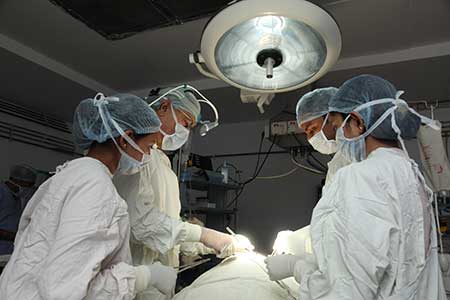


Coronary Artery Bypass Grafting (CABG), also known as Coronary Artery Bypass Surgery & popularly Heart Bypass or Bypass Surgery, is a surgical procedure to restore normal blood flow to an obstructed coronary artery. Obstructed coronary artery means when the coronary arteries are narrowed or occluded, most commonly by atherosclerotic deposits of fibrous and fatty tissue.
A) Typical :
Angina
Chest discomfort
Breathlessness
Jaw Pain
B) Atypical :
Syncope
Vomiting
Unexplained sweating
Epigastric- discomfort
Myocardial infarction
Dyspnea
Arrhythmia
Cardiac failure
Sudden death
Silent Ischemia
Left main disease
Left main equivalent
Critical TVD
MI with its Mechanical complications
Chronic total occlusion
Length of lesion 13-18 mm – 30% re-stenosis
Bifurcation and ostial lesions
Vessel size < 2.5mm - 37% re-stenosis
> 3.5mm – 7% re-stenosis
Diffuse In – stent Stenosis
Diabetes – better results with CABG
It is performed to relieve angina (a pain that radiates in the upper left quadrant of the body due to the lack of oxygen reaching the heart)
Unsatisfactorily controlled by maximum tolerated anti-ischemic medication
Prevent or relieve left ventricular dysfunctions (eg. LVH), and/or reduce the risk of death.
Arterial Grafting :
The left internal thoracic artery (internal mammary artery) is diverted to the left anterior descending branch of the left coronary artery.
Venous Grafting :
In the other, a great saphenous vein is removed from a leg; one end is attached to the aorta or one of its major branches, and the other end is attached to the obstructed artery immediately after the obstruction to restore blood flow.
A) Regularly performing Off-pump CABG : A coronary artery bypass graft (CABG) is done without putting the patient on the heart-lung machine. Off-pump CABG permits surgery on multiple vessels within the heart by mechanically stabilizing it. Off-pump surgery is minimally invasive, as compared to surgery on the heart-lung machine.
Advantages:
Less number of Mortality rate
No aortic cannulation -> less risk of dissection, embolism
No atrial cannulation -> less atrial injury, arrhythmias
No cross-clamping -> less risk of plaque embolism, CVA, MI
No activation of co-angulation, kallikrein, inflammation caused by tubing -> less coagulopathy, less bleeding, less transfusion
No cardioplegia -> no K+ load, fluid load, coronary air embolism
No risk of bypass machine failure -> air embolism
less equipment
less staff requirement
B) Desun Performs minimally invasive cardiac surgery : Most cardiac operations today are performed through a sternotomy, which involves splitting the entire breastbone. Minimally invasive cardiac surgery encompasses a variety of operations performed through incisions that are substantially smaller and less traumatic than the standard sternotomy. Minimally invasive incisions measure about 3 to 4 inches compared to 8 to 10 sternotomy incisions. Specialized handheld and robotic instruments are used to project the dexterity of the surgeon’s hands through these small incisions in performing the operations.

Standard Sternotomy Incision
This 8 to 10 inch incision splits the
entire breastbone.

Mini-Sternotomy Incision
This 4 to 5 inch incision just splits the upper
third of the breastbone.

Mini-Thoracotomy Incision
This 3 to 4 inch incision is made between the
ribs whereby no bone is cut.

Port-access Incision
Robotic instruments are passed through several
1/2 inch incisions between the ribs.
Minimally invasive surgery confers many advantages over standard approaches derived largely from the reduced trauma to the chest wall tissues. The benefits of minimally invasive cardiac surgery include:
Smaller incisions
Smaller scars
Reduced infection risk
Less blood loss
Less pain
Shorter hospital stays : Stays after minimally invasive operations are from 3 to 5 days compared to 5 to 7 days for traditional sternotomy-based cardiac operations.
Fewer physical restrictions : Patients undergoing standard incision cardiac operations are restricted from driving an automobile or lifting objects weighing more than 5 pounds while patients undergoing minimally invasive cardiac surgery are not subject to these restrictions.
Shorter recovery time : Recovery times after minimally invasive operations are from 2 to 4 weeks compared to 6 to 8 weeks for standard sternotomy-based cardiac operations.